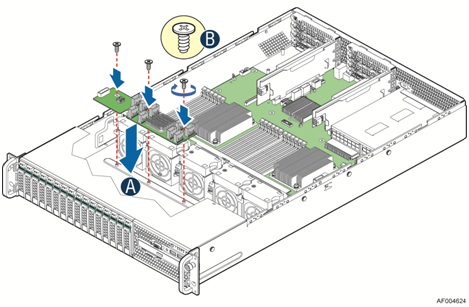Hardware User Guide for Intel® RAID Expander RES2CV240 and RES2CV360
This article provides Installation instructions and specifications for the RES2CV240 24-port SAS Expander Card that ships with the Intel® Server System R2216GZ4GC and the RES2CV360 36-port SAS Expander Card that ships with the Intel® Server System R2224GZ4GCSAS.
For large storage configurations that utilize more than eight 2.5 inch hard disk drives, the system may be configured with an internally mounted SAS expander card mounted directly behind the drive bay assembly as shown in the following illustration. SAS expander selection is dependent on the desired SAS controller configuration.

The following diagrams are used to help identify the mini-SAS connectors found on the SAS expander cards. Care should be taken when connecting connectors from the SAS expander to the connectors on the backplane, because each connector is pre-programmed at the factory to provide specific drive identification mapping. Improper connections may provide undesirable drive mappings.




Each connector on the SAS expander card can be used as a “cable in” (SAS Controller to SAS Expander) or “cable out” (SAS Expander to Hot Swap Backplane) type connector. However, for contiguous drive mapping (0–16 or 0– 24), cable routing differs when using a x8 wide-port capable 6 Gb SAS/SAS RAID Controller vs. using the embedded SCU ports.
Cable Routing using a x8 wide-port capable 6 Gb SAS/SAS RAID Controller
To ensure contiguous drive mapping when using x8 wide-port capable 6 Gb SAS/SAS RAID Controller with a SAS expander card, the system must be cabled as follows:
- Cables from the SAS Expander to the hot swap backplane must be connected in order: A–D for 16-drive configurations, and A–F for 24-drive configurations.
- The cables from the SAS controller can be attached to any of the remaining connectors on the SAS expander card.
Cable Routing using the embedded SCU ports
Note: The following may also be applied when using any 3 Gb SAS/SAS RAID Controller.
For storage configurations that utilize up to 16 or 24 hard disk drives for storage only and an internally mounted SSD as a boot device, the system must be configured as follows to ensure contiguous drive mapping (0–16 or 0–24):
- At least one internally mounted SSD device must be attached to the AHCI controller (SATA_0 or SATA_1 on the server board) and used as a boot device.
- Cables from the SAS Expander to the hot swap backplane must be connected in order: B–E for 16-drive configurations, and B–G for 24-drive configurations.
- The SCU_0 or 3G SAS/SAS RAID (0-3) connector is cabled to the first mini-SAS connector on the hot swap backplane.
- The SCU_1 or 3G SAS/SAS RAID (4-7) connector is cable to Connector A on the SAS expander card.
For storage configurations that require utilizing a hard disk drive as the boot device, the system must be cabled as follows to ensure a boot device is found and for contiguous drive mapping (0-16 or 0-24):
- The SCU_0 (0-3) connector on the server board is cabled to the first mini-SAS connector on the hot swap backplane.
- The SCU_1 (4-7) connector on the server board is cable to Connector_A on either the 24-port or 36-port SAS expander card.
- Cables from the SAS Expander to the hot swap backplane must be connected in order: B–F on the 24-port expander card, and B–G on the 36-port expander card.
| Note | Current SCU controller design limitations prevent any hard drive attached to a SAS expander card from being a boot device when both SCU connectors are attached to the SAS expander card. |
Please reference the Intel® Server System R2000GZ/GL Product Family Service Guide for cable routing diagrams illustrating a variety of different storage configurations.